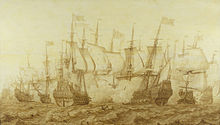|
Battle of the Gabbard
The Battle of the Gabbard,[a] was a naval battle fought from 2 to 3 June 1653 [b] during the First Anglo-Dutch War. It took place near the Gabbard shoal off the coast of Suffolk, England, between fleets of the Commonwealth of England and the Dutch Republic. It resulted in a significant English victory.[3] BattleThe English fleet had 100 ships commanded by Generals at Sea George Monck and Richard Deane and Admirals John Lawson and William Penn. The Dutch had 98 ships under Lieutenant-Admiral Maarten Tromp and Vice-admiral Witte de With, divided in five squadrons. On 2 June 1653 the Dutch attacked but were beaten back because the English employed line-of-battle tactics, making the Dutch pay a high price for attempting to board. The Dutch fleet, consisting of lighter ships, was severely damaged and lost two ships.[4] Tromp's fleet was organized mostly for mélée fighting. His ships were crewed with a much greater proportion of soldiers for that purpose than the English, whose methods employed the use of superior heavy guns and with musketry fire. That could overwhelm the enemy’s upper decks, with attention aimed at officers, followed up with grappling and boarding, with the objective of leaving relatively few crewmen below deck who would be committed to manning the cannons. Tromp also relied far more on the use of fireships to finish off damaged or inoperable ships, relying on his superior seamanship and experience to out- maneuver the English so as to concentrate his whole strength against a single division.[5] On 3 June the English were joined by Admiral Robert Blake, but Tromp decided to try again a direct attack though his ships were practically out of ammunition. A sudden lull however made his ships sitting ducks for the superior English guns. The Dutch were routed, the English chasing them until well in the evening, capturing many Dutch ships. The battle ended with the Dutch losing a total of twenty ships, of which nine were sunk and eleven captured.[2] The English lost no ships, but Deane was killed. Tactically this was the worst defeat in Dutch naval history with the exception of the Battle of Lowestoft. Strategically the defeat threatened to be disastrous.[4]  The victory meant that the English control over the English Channel, regained by the Battle of Portland in March after it had been lost in the Battle of Dungeness, was now extended to the North Sea. After the battle, the English imposed a blockade on the Dutch coast, capturing many merchant ships and crippling the Dutch economy . The fleets met again on 29–31 July 1653 (8–10 August 1653 Gregorian calendar) at the Battle of Scheveningen.[4] Reports of the battle were read in London with great exclamation. The victorious battle was the first great naval action which England had fought since the reign of Elizabeth I.[6] Ships involved
See also
Notes
References
Sources
|
|||||||||||||||||||||||||||||||||||||||||||||||||||||||||||||||||||||||||||||||||||||||||||||||||||||||||||||||||||||||||||||||||||||||||||||||||||||||||||||||||||||||||||||||||||||||||||||||||||||||||||||||||||||||||||||||||||||||||||||||||||||||||||||||||||||||||||||||||||||||||||||||||||||||||||||||||||||||||||||||||||||||||||||||||||||||||||||||||||||||||||||||||||||||||||||||||||||||||||||||||||||||||||||||||||||||||||||||||||||||||||||||||||||||||||||||||||||||||||||||||||||||||||||||||||||||||||||||||||||||||||||||||||||||||||||||||||||||||||||||||||||||||||||||||||||||||||||||||||||||||||||||||||||||||||
